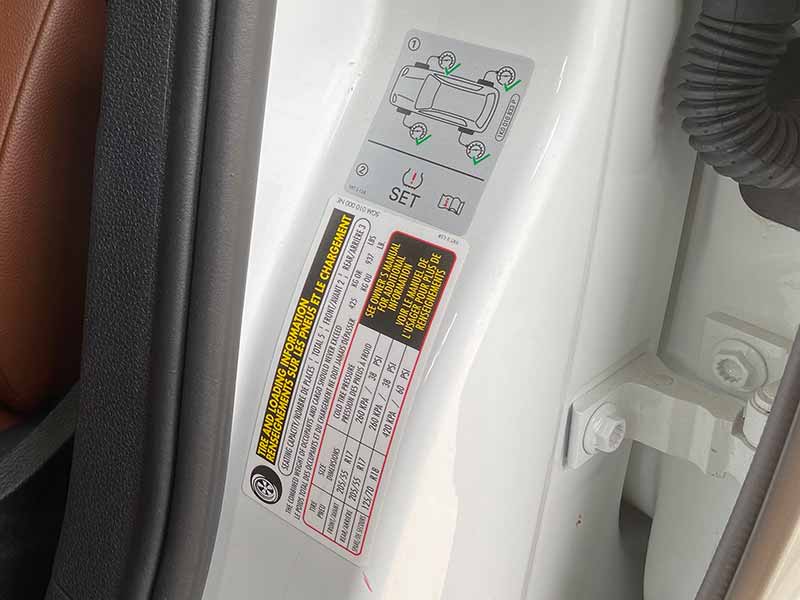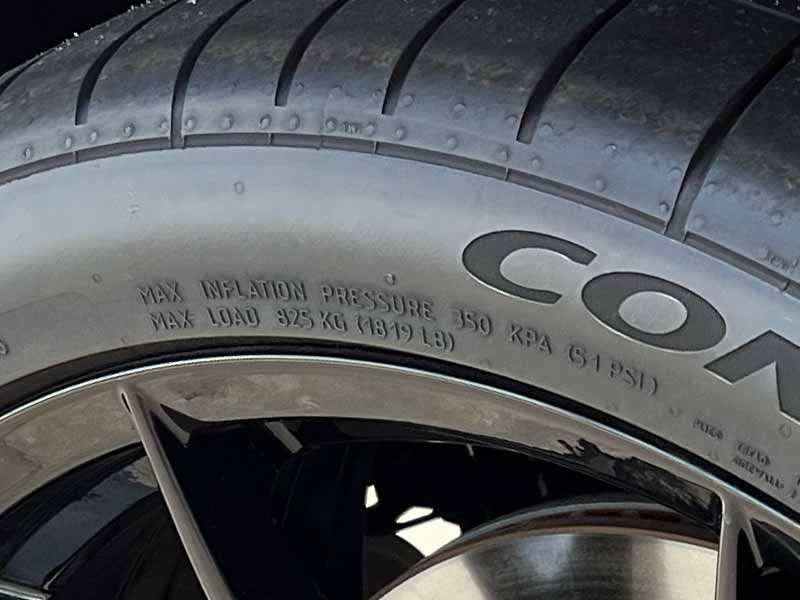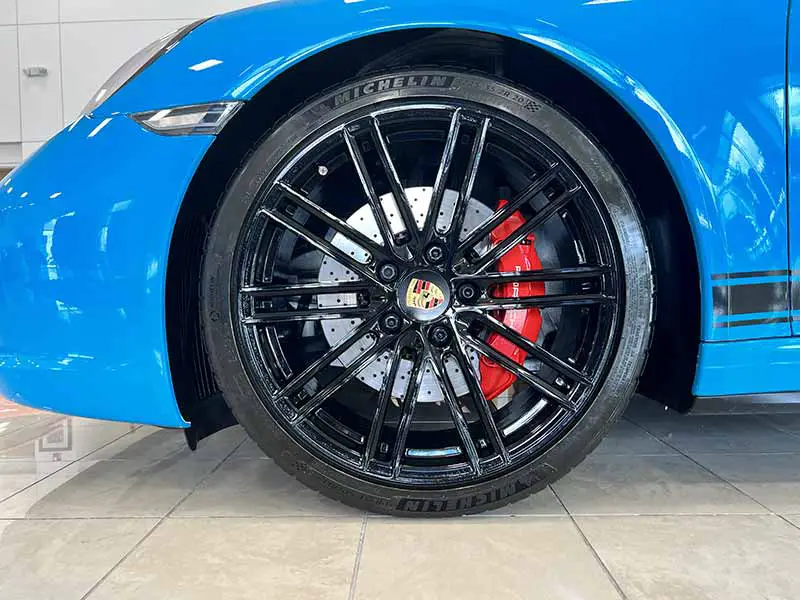Have you ever glanced at the sleek, low profile tires on a sports car and wondered about the right air pressure for them? Ensuring the correct tire pressure is crucial, not just for the tire’s longevity but also for your safety on the road.
What PSI Should Low Profile Tires Be?
Low profile tires often require a slightly different PSI than regular tires. You can use our tire pressure chart to find the proper air pressure using the current OEM tire pressure and load index when changing the tire aspect ratio.
The OEM air pressure and load index can be found on the tire’s sidewall or in the vehicle owner’s manual.
In this article, we’ll delve deep into understanding low profile tires, their recommended pressures, and the significance of maintaining the right PSI. We’ll also provide a handy tire pressure chart and guide you on how to use it effectively.
Let’s take a closer look.
Low Profile Tire Pressure Chart
The following table allows you to find the load carrying capacity (in pounds) of standard tires based on the load index and air pressure.
| LOAD INDEX | 24 PSI | 25 PSI | 26 PSI | 27 PSI | 28 PSI | 29 PSI | 30 PSI | 31 PSI | 32 PSI | 33 PSI | 34 PSI | 35 PSI | 36 PSI |
|---|---|---|---|---|---|---|---|---|---|---|---|---|---|
| 80 | 699 | 728 | 757 | 785 | 814 | 843 | 871 | 900 | 928 | 957 | 986 | 1014 | 1043 |
| 81 | 719 | 749 | 779 | 809 | 839 | 869 | 899 | 929 | 959 | 989 | 1019 | 1049 | 1079 |
| 82 | 740 | 770 | 801 | 831 | 862 | 893 | 923 | 954 | 984 | 1015 | 1046 | 1076 | 1107 |
| 83 | 760 | 792 | 823 | 855 | 886 | 918 | 949 | 981 | 1012 | 1044 | 1075 | 1107 | 1138 |
| 84 | 781 | 814 | 846 | 879 | 911 | 944 | 976 | 1009 | 1041 | 1074 | 1106 | 1139 | 1171 |
| 85 | 802 | 836 | 869 | 903 | 936 | 970 | 1003 | 1037 | 1070 | 1104 | 1137 | 1171 | 1204 |
| 86 | 824 | 859 | 893 | 928 | 962 | 997 | 1031 | 1066 | 1100 | 1135 | 1169 | 1204 | 1238 |
| 87 | 846 | 882 | 918 | 954 | 990 | 1026 | 1062 | 1098 | 1134 | 1170 | 1206 | 1242 | 1278 |
| 88 | 869 | 906 | 943 | 980 | 1017 | 1054 | 1091 | 1128 | 1165 | 1202 | 1239 | 1276 | 1313 |
| 89 | 892 | 930 | 968 | 1006 | 1044 | 1082 | 1120 | 1158 | 1196 | 1234 | 1272 | 1310 | 1348 |
| 90 | 916 | 955 | 994 | 1033 | 1072 | 1111 | 1150 | 1189 | 1228 | 1267 | 1306 | 1345 | 1384 |
| 91 | 940 | 980 | 1020 | 1060 | 1100 | 1140 | 1180 | 1220 | 1260 | 1300 | 1340 | 1380 | 1420 |
| 92 | 965 | 1006 | 1047 | 1088 | 1129 | 1170 | 1211 | 1252 | 1293 | 1334 | 1375 | 1416 | 1457 |
| 93 | 990 | 1032 | 1074 | 1116 | 1158 | 1200 | 1242 | 1284 | 1326 | 1368 | 1410 | 1452 | 1494 |
| 94 | 1016 | 1059 | 1102 | 1145 | 1188 | 1231 | 1274 | 1317 | 1360 | 1403 | 1446 | 1489 | 1532 |
| 95 | 1042 | 1086 | 1130 | 1174 | 1218 | 1262 | 1306 | 1350 | 1394 | 1438 | 1482 | 1526 | 1570 |
| 96 | 1069 | 1114 | 1159 | 1204 | 1249 | 1294 | 1339 | 1384 | 1429 | 1474 | 1519 | 1564 | 1609 |
| 97 | 1097 | 1143 | 1189 | 1235 | 1281 | 1327 | 1373 | 1419 | 1465 | 1511 | 1557 | 1603 | 1649 |
| 98 | 1125 | 1172 | 1219 | 1266 | 1313 | 1360 | 1407 | 1454 | 1501 | 1548 | 1595 | 1642 | 1689 |
| 99 | 1154 | 1202 | 1250 | 1298 | 1346 | 1394 | 1442 | 1490 | 1538 | 1586 | 1634 | 1682 | 1730 |
| 100 | 1183 | 1232 | 1281 | 1330 | 1379 | 1428 | 1477 | 1526 | 1575 | 1624 | 1673 | 1722 | 1771 |
| 101 | 1213 | 1263 | 1313 | 1363 | 1413 | 1463 | 1513 | 1563 | 1613 | 1663 | 1713 | 1763 | 1813 |
| 102 | 1243 | 1295 | 1347 | 1399 | 1451 | 1503 | 1555 | 1607 | 1659 | 1711 | 1763 | 1815 | 1867 |
| 103 | 1274 | 1328 | 1382 | 1436 | 1490 | 1544 | 1598 | 1652 | 1706 | 1760 | 1814 | 1868 | 1922 |
| 104 | 1306 | 1361 | 1416 | 1471 | 1526 | 1581 | 1636 | 1691 | 1746 | 1801 | 1856 | 1911 | 1966 |
| 105 | 1338 | 1395 | 1452 | 1509 | 1566 | 1623 | 1680 | 1737 | 1794 | 1851 | 1908 | 1965 | 2022 |
| 106 | 1371 | 1430 | 1489 | 1548 | 1607 | 1666 | 1725 | 1784 | 1843 | 1902 | 1961 | 2020 | 2079 |
| 107 | 1405 | 1466 | 1527 | 1588 | 1649 | 1710 | 1771 | 1832 | 1893 | 1954 | 2015 | 2076 | 2137 |
| 108 | 1440 | 1503 | 1566 | 1629 | 1692 | 1755 | 1818 | 1881 | 1944 | 2007 | 2070 | 2133 | 2196 |
| 109 | 1476 | 1541 | 1606 | 1671 | 1736 | 1801 | 1866 | 1931 | 1996 | 2061 | 2126 | 2191 | 2256 |
| 110 | 1513 | 1580 | 1647 | 1714 | 1781 | 1848 | 1915 | 1982 | 2049 | 2116 | 2183 | 2250 | 2317 |
| 111 | 1551 | 1620 | 1689 | 1758 | 1827 | 1896 | 1965 | 2034 | 2103 | 2172 | 2241 | 2310 | 2379 |
| 112 | 1590 | 1661 | 1732 | 1803 | 1874 | 1945 | 2016 | 2087 | 2158 | 2229 | 2300 | 2371 | 2442 |
| 113 | 1630 | 1703 | 1776 | 1849 | 1922 | 1995 | 2068 | 2141 | 2214 | 2287 | 2360 | 2433 | 2506 |
| 114 | 1671 | 1746 | 1821 | 1896 | 1971 | 2046 | 2121 | 2196 | 2271 | 2346 | 2421 | 2496 | 2571 |
| 115 | 1713 | 1790 | 1867 | 1944 | 2021 | 2098 | 2175 | 2252 | 2329 | 2406 | 2483 | 2560 | 2637 |
| 116 | 1756 | 1835 | 1914 | 1993 | 2072 | 2151 | 2230 | 2309 | 2388 | 2467 | 2546 | 2625 | 2704 |
| 117 | 1800 | 1881 | 1962 | 2043 | 2124 | 2205 | 2286 | 2367 | 2448 | 2529 | 2610 | 2691 | 2772 |
| 118 | 1845 | 1928 | 2011 | 2094 | 2177 | 2260 | 2343 | 2426 | 2509 | 2592 | 2675 | 2758 | 2841 |
| 119 | 1891 | 1976 | 2061 | 2146 | 2231 | 2316 | 2401 | 2486 | 2571 | 2656 | 2741 | 2826 | 2911 |
| 120 | 1938 | 2025 | 2112 | 2199 | 2286 | 2373 | 2460 | 2547 | 2634 | 2721 | 2808 | 2895 | 2982 |
| 121 | 1986 | 2075 | 2164 | 2253 | 2342 | 2431 | 2520 | 2609 | 2698 | 2787 | 2876 | 2965 | 3054 |
| 122 | 2035 | 2126 | 2217 | 2308 | 2399 | 2490 | 2581 | 2672 | 2763 | 2854 | 2945 | 3036 | 3127 |
| 123 | 2085 | 2178 | 2271 | 2364 | 2457 | 2550 | 2643 | 2736 | 2829 | 2922 | 3015 | 3108 | 3201 |
| 124 | 2136 | 2231 | 2326 | 2421 | 2516 | 2611 | 2706 | 2801 | 2896 | 2991 | 3086 | 3181 | 3276 |
| 125 | 2188 | 2285 | 2382 | 2479 | 2576 | 2673 | 2770 | 2867 | 2964 | 3061 | 3158 | 3255 | 3352 |
How to Use the Tire Pressure Table for Standard Load Tires
- Identify Your Tire’s Load Index:
- The load index is a numerical code associated with the maximum load a tire can carry. It’s usually found on the sidewall of the tire, following the tire size. For example, in the tire size “205/55R16 91V”, the load index is “91”.
- Locate the Load Index on the Table:
- Scan the first column of the table until you find the load index that matches the one on your tire.
- Locate the Load Carrying Capacity on the Table:
- Once you’ve located the correct load index row, move horizontally across the row to find the corresponding OEM tire pressure. The table cell that aligns with the OEM load index and tire pressure is the current load carrying capacity of your passenger tire.
- Find the Correct Air Pressure for Your New Low Profile Tires:
- Using the load index of your new low profile tires, find the matching load carrying capacity and the column header will list the new proper tire pressure to prevent uneven tire wear and optimal handling.
- Adjust Tire Pressure Accordingly:
- Use a reliable tire pressure gauge to check the current pressure of your tires. If the pressure is outside the range recommended by the table and your vehicle’s specifications, adjust it accordingly. Remember to check the tire pressure when the tires are cold (i.e., haven’t been driven on for at least three hours) for the most accurate reading.
- Safety First:
- Never inflate a tire beyond its maximum pressure, which can also be found on the tire sidewall. Overinflation can lead to reduced traction, uneven tire wear, and even a blowout.
- Conversely, underinflated tires can cause poor fuel economy, sluggish handling, and excessive heat buildup leading to tire failure.
- Regularly Check Tire Pressure:
- Tire pressure should be checked at least once a month and before long trips. Regularly checking and maintaining the correct tire pressure ensures optimal performance, safety, and longevity of your tires.

The Importance of Correct Tire Pressure
Tire pressure is how much air is inside your tire. It’s important to make sure your tires have the right amount of air. Let’s talk about why this is so important.
Why Is Tire Pressure Important?
There are a few big reasons:
- Safety: Tires with the right amount of air grip the road better. This means you can stop quickly if you need to. It also means your car won’t slide around on wet roads.
- Save Money: Tires with the correct pressure can help you use less gas. This means you don’t have to fill up your gas tank as often.
- Tire Life: Tires last longer when they have the right amount of air. If they don’t, they can wear out faster.
What Happens If Tire Pressure Is Wrong?
If there’s too much or too little air in your tires, you might notice:
- Harder to Drive: Your car might not handle well. It could feel like it’s pulling to one side.
- More Gas Used: Your car might use more gas than usual.
- Tire Damage: Your tires could get damaged. They might even burst if there’s too much air.

Recommended Tire Pressure vs. Maximum Pressure
Tire pressure is crucial for safe driving and the overall health of your tires. When we talk about tire pressure, two terms often come up: “recommended tire pressure” and “maximum pressure” or “Max Pressure.” Let’s dive into what these terms mean and how they differ.
What is Recommended Tire Pressure?
- Definition: This is the ideal amount of air that should be in your tires for everyday driving. It ensures optimal performance, safety, and tire lifespan.
- Where to Find It: The recommended tire pressure is usually found:
- On a sticker inside the driver’s door or fuel door.
- In the vehicle’s manual.
- Purpose: This pressure:
- Provides the best balance between performance, comfort, and fuel efficiency.
- Reduces tire wear, ensuring your tires last longer.
- Keeps you safe by ensuring good grip and handling on the road.
What is Max Pressure?
- Definition: This is the highest amount of air a tire can safely hold. It’s not what you should aim for in daily driving.
- Where to Find It: The maximum pressure is often printed on the tire’s sidewall. It’s usually next to the tire size and is followed by “PSI” or “kPa.”
- Purpose: This pressure:
- Is NOT for regular driving. It’s the limit you shouldn’t cross.
- Can be used as a reference when carrying heavy loads, but you should never exceed it.
- Indicates the tire’s safety limit. Going beyond can risk a blowout or rapid tire failure.

Understanding Low Profile Tires
Low profile tires are a type of tire that many people choose for their cars and trucks. Let’s break down what they are and why some people like them.
What Are Low Profile Tires?
- Low profile tires have less rubber between the wheel and the road.
- This means the tire’s “side” (called the sidewall) is shorter than on regular tires.
Why Do People Choose Low Profile Tires?
There are a few reasons why someone might pick low profile tires for their vehicle:
- Looks: Some people think they make a car or truck look sportier or more stylish.
- Handling: These tires can make a car feel more connected to the road. This can be good for quick turns.
Are There Any Drawbacks?
Yes, there are some things to think about:
- Comfort: Because there’s less rubber, you might feel bumps in the road more.
- Damage: They can get damaged more easily. For example, if you hit a big pothole, the tire might get punctured or wheel might get bent.
How to Tell If You Have Low Profile Tires
If you’re not sure what kind of tires you have, here’s a simple way to check:
- Look at the tire’s side.
- You’ll see some numbers and letters. This is the tire size.
- The middle number tells you about the profile. A smaller number means it’s a low profile tire. For example, in “225/45R17”, the “45” means it’s a low profile tire.
Should You Get Low Profile Tires?
It depends on what you want:
- If you like the look and don’t mind feeling the road more, they might be a good choice.
- If you want a smoother ride or are worried about damage, you might want to think about other options.
Resources
Below are some links you may find helpful when learning about tires
Final Thoughts
While low profile tires can offer enhanced handling and a sportier look, they also come with their set of considerations. Always adhere to the recommended tire pressure, cross-referencing with your vehicle’s specifications.
Regularly checking and adjusting your tire pressure can lead to optimal performance, increased tire lifespan, and most importantly, a safer driving experience. Whether you’re a car enthusiast or just someone looking to understand their vehicle better, being informed about tire pressure is a step in the right direction.
Good luck and happy motoring.





